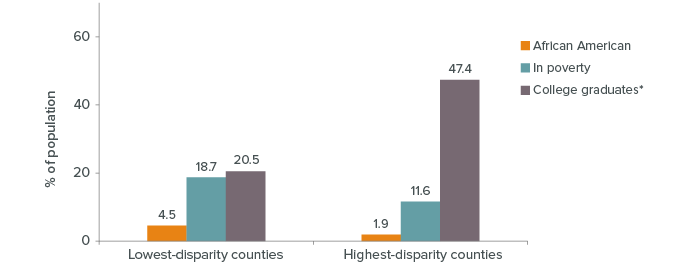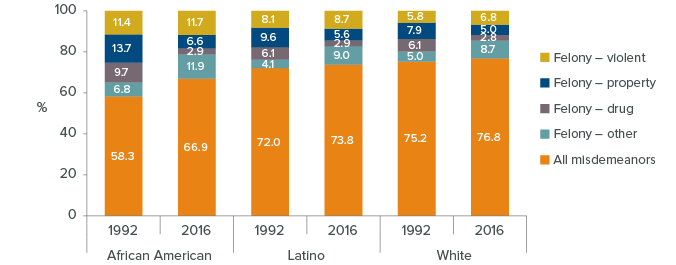- Racial disparities in arrests have decreased, but they still persist statewide.
Racial disparities in arrests peaked in 1992 when the African American arrest rate—the number of arrests per 100,000 African Americans—was 3.6 times greater than the white arrest rate, and the Latino arrest rate was 1.8 times greater than the white arrest rate. Although these disparities have narrowed, in 2016 the African American arrest rate was still 3.0 times the white arrest rate, and the Latino arrest rate was 1.1 times as high. - Disparities in arrests between African Americans and whites are widespread.
African Americans have higher arrest rates than whites in nearly all of California’s 58 counties. In counties with the largest racial disparities, the African American arrest rate is on average about six times higher than the white arrest rate, compared to almost double among counties with the lowest racial disparities. In contrast, the disparities between Latino and white arrest rates are less widespread. In fact, Latinos were arrested at lower rates than whites in 26 counties. - Racial disparities are larger in more affluent, less diverse counties.
Demographics and economic conditions vary greatly across counties with lower and higher racial disparities. For instance, among California’s largest 49 counties, those with the greatest racial disparities between African Americans and whites have higher median household incomes ($76,700 per year) and lower average poverty rates (11.6%) than counties with the lowest racial disparities ($51,100 and 18.7%, respectively). Counties with higher educational attainment also tend to have greater racial disparities in arrests: the share of college graduates is 47.4% in the highest-disparity counties, compared with 20.5% in the lowest-disparity counties. Notably, counties with the largest racial disparities have lower shares of African American residents than counties with the lowest racial disparities (1.9% versus 4.5%).
Counties with larger racial disparities in arrests tend to have lower shares of African Americans and lower poverty rates, but they have higher shares of college graduates

SOURCES: Authors’ calculations based on California Department of Justice’s Monthly Arrest and Citation Register and California Department of Finance Population Data, and the US Census Bureau’s Small Area Income and Poverty Estimates Program 2014–16.
NOTES: Arrest rates are the number of arrests made by law enforcement agencies per 100,000 residents. *Data available only for the 41 largest counties. Each bar reflects the average for the first (lowest) and fifth (highest) quintiles of counties grouped by the ratio of African American arrest rates divided by white arrest rates.
- Felony arrest rates have fallen, especially for African Americans and Latinos.
In 1992, the African American felony arrest rate was 7,217 per 100,000 residents, compared to 2,455 for Latinos and 1,198 for whites. Since then, the disparities in felony arrests rates have narrowed, with rates decreasing to 3,229 for African Americans (a 55% decline), 945 for Latinos (62% decline), and 751 for whites (37% decline). African Americans now constitute a smaller share of all felony arrests than in the past. In 2016, African Americans made up 20.5% of all felony arrests—a decline from 26.3% in 1992. - The overall share of felony arrests has decreased across racial/ethnic groups.
In 2014, Proposition 47 reclassified several drug and property offenses from felonies to misdemeanors, which appears to have affected the overall shares of felony arrests. In 1992, arrests for property felonies represented 13.7% of all arrests of African Americans, 9.6% of Latino arrests, and 7.9% of white arrests. In contrast, the shares of felony property arrests were much smaller in 2016, constituting 6.6% of African American arrests, 5.6% of Latino arrests, and 5.0% of white arrests. The share of felony drug arrests also declined considerably for each racial/ethnic group, while the share of felony violent arrests increased slightly for each group. - Misdemeanors have grown as a share of all arrests.
While the shares of violent and drug-related misdemeanors have increased, the share of misdemeanor property arrests has declined. In 1992, arrests for violent misdemeanors made up 4.7% of all arrests of African Americans, 3.2% of Latino arrests, and 4.5% of white arrests; in 2016, these shares grew to 7.5%, 5.9%, and 5.5%, respectively. Similarly, misdemeanor drug arrests have also grown as a share of all arrests, particularly for Latinos and whites. Once again, Proposition 47 likely contributed to this change in misdemeanor drug arrests. However, the share of misdemeanor property arrests decreased slightly—by less than a percentage point for whites and African Americans, and by 2.3 percentage points for Latinos.
Felony arrests now make up smaller shares of arrests across racial/ethnic groups

SOURCE: Authors’ calculations based on California Department of Justice’s Monthly Arrest and Citation Register.
Topics
Criminal Justice Population




